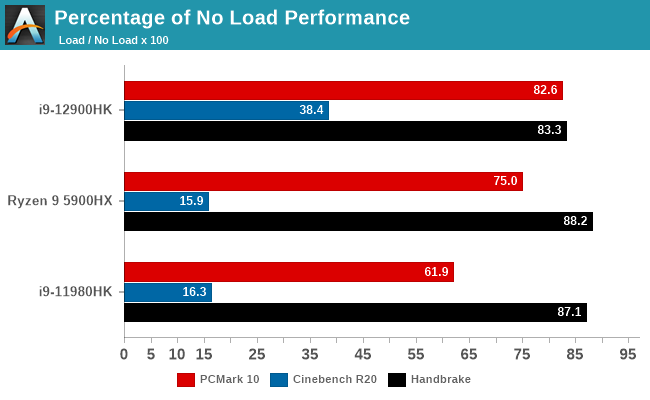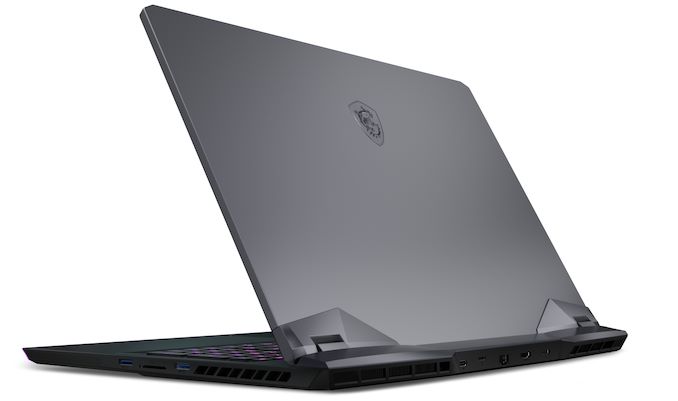Intel Alder Lake-H Core i9-12900HK Review: MSI's Raider GE76 Goes Hybrid
by Brett Howse on January 25, 2022 9:00 AM EST- Posted in
- CPUs
- Intel
- MSI
- Laptops
- Alder Lake
- GE76 Raider
- 12th Gen Core
- Alder Lake-H
Initial Thoughts
Intel has been consistent over the last several years to bring their low-power processors to market first, and then move towards the higher-performance platforms and desktops. With the laptop market being the majority of sales, this has made a lot of sense, but it most certainly has left the desktop crowd at a disadvantage. With Alder Lake, Intel has flipped that around completely by launching the desktop products first, and are now just moving down to high-performance laptops, and then finally low-power notebooks. The Core i9-12900HK at the heart of the MSI Raider GE76 is our first taste of Alder Lake in a portable system, and it tastes delicious.
The new hybrid CPU design delivers in multiple ways. Outright performance easily exceeds everything else on the market. The new Golden Cove P-Cores offer a significant uplift in terms of instructions-per-clock (IPC) and allow Intel to regain the single-thread performance crown. Having twenty threads available in a laptop processor also gives Intel the multi-threaded performance lead.
Perhaps the most impressive result though is Intel’s Thread Director, which provides very impressive system responsiveness even when the system is at 100% CPU load. Tasks that are being done in the background are still done quickly, but no longer at the expense of the user, and without having to manually adjust thread priority. This is a major win.

The supplied MSI Raider GE76 with the i9-12900HK and GeForce RTX 3080 Ti for Laptops also showcased increased gaming performance, although the increases were more subtle than the system performance results. At 1920x1080, the Alder Lake system almost universally provided a reasonable uptick in gaming performance, although the 3080L Ti GPU did not significantly move the yardstick at UHD resolutions.
Intel has also been able to integrate the CPU and chipset into one package for the 12th generation H-Series processors, and that System-on-Chip provides a lot of connectivity and expansion options, as well as compatibility with four different memory choices in DDR4, DDR5, LPDDR4, and LPDDR5. There is support for four Thunderbolt 4 controllers, as well as two by four lanes of PCIe 4.0 for storage, and another eight lanes for graphics and an additional twelve lanes of PCIe 3.0. Intel now also includes Iris Xe-LP graphics in their H-Series, with the full 96 Execution Units on tap with the Core i9-12900HK.
The one downside from sampling the MSI Raider GE76 was that it's a laptop designed to show off Alder Lake at its best with regards to performance, but at the expense of more mobile-friendly matters such as portability, energy efficiency, and battery life. Case in point: despite having the largest possible battery allowed in a notebook at 99.9 Wh, the base system power draw of the Raider was significant, making battery life poor and masking any changes that would have been a result of the CPU. Intel is aiming Alder Lake-H at everything from luggable desktop replacements such as the Raider to 14-inch ultraportable laptops, so there is a second side to Alder Lake that we've still yet to see. Once more laptops start shipping – especially the U-Series with LPDDR5 – we should get a much better feel for how the hybrid CPU design does when the device is running off the battery.
Thankfully, the lack of battery life was really the only negative for the MSI Raider GE76. It offers plenty of cooling, a great display, and offers the most potent laptop GPU on the market. The Tiger Lake version was the quickest laptop we had tested, but the new Alder Lake one takes things to another level. It is simply one of the best gaming notebooks on the market right now, and it's easy to see why Intel picked this laptop to show off the performance capabilities of Alder Lake-H.
Alder Lake appears to be a significant step forward for Intel, with commanding single-threaded performance, exceptional multi-threaded performance, and the benefits of Thread Director to increase system responsiveness. Alder Lake was a step forward for desktops, but likely an even larger step forward for notebook computers. Intel has delivered tremendous performance across the board and the gap is not even close. 2022 is shaping up to be an exciting year again.












153 Comments
View All Comments
Lbibass - Tuesday, January 25, 2022 - link
It seems that there may be something wrong with your benchmarking process. Linus Tech Tips was getting significantly improved battery life over the previous gen GE76 Raider in watching YouTube videos, nearly a 40% improvement.For the Alder Lake Raider in your review to get significantly less battery life than the previous gen shows signs that there is something going on with your specific laptop that I wouldn’t be so quick to blame on background power consumption.
doungmli - Tuesday, January 25, 2022 - link
you have to see the configuration tested, here the autonomy problem is surely linked to the 17" 360hz screen. I don't even understand their comparison with the asus g513 which has a 15" screen ans only 144hzBrett Howse - Tuesday, January 25, 2022 - link
Our results were very close to what Intel had sent us as to what they were getting so I think they are fine.TheinsanegamerN - Friday, January 28, 2022 - link
But they are not in the same ball park with what other reviewers are getting. It suggests either there was a difference in the manner the laptop was tested or there was something off about this specific model you got.deil - Thursday, February 10, 2022 - link
or that drivers still suck, it did not go to E-cores as planned, hence the difference.Silma - Tuesday, January 25, 2022 - link
The laws of physics are the laws of physics.On battery life and performance per watt, Intel won't catch up with AMD until it goes 7 nm, and then again, it won't catch up with Apple until it goes 5 nm, assuming the change is immediate.
In reality Intel will probably needs to go 4 or 3 nm to catch up.
drothgery - Tuesday, January 25, 2022 - link
Intel 7 and TSMC N7 are similar-density processes (though the latter is more power efficient). That until was calling Intel 7 "10nm Enhanced Superfin" until recently and people who should know better always called TSMC N7 "7nm" doesn't actually make them that different. Neither process actually has any 7nm features, or even any 10nm features; the last time marketing names for semiconductor processes actually reflected any feature size on real chips they were still using microns, not nanometers.Otritus - Friday, January 28, 2022 - link
Planar transistors had size match the smallest dimension of the transistor. So 28nm was in fact 28nm. The move to FinFET dramatically decreased the smallest dimension (14/16 nm would be called 8nm if they didn’t change how transistors were named). Since there is not standardized naming for FinFET and GAAFET transistors you have the arbitrary naming that all companies now use creating confusion around how performant and dense a process is.Duwelon - Tuesday, January 25, 2022 - link
Wonder why they don't offer a 144hz VA panel.Calin - Wednesday, January 26, 2022 - link
That is a $3000 laptop, they can't use "second-best" technologies in it.(and by the way, I have a "second-best" MVA 32 inch display, and the contrast is absolutely incredible. Colors are good, viewing angles are good, but that contrast <3